
The Visvesvaraya Industrial and Technological Museum (VITM), Bangalore, India, a constituent unit of the National Council of Science Museums (NCSM), Ministry of Culture, Government of India, was established in memory of Sir M. Visvesvaraya. The 4,000 m2 (43,000 sq ft) building was constructed in Cubbon Park, and was inaugurated by the first Prime Minister of India, Pandit Jawaharlal Nehru, on July 14, 1962. The museum displays industrial products, scientific models and engines.

The National Space Centre is a museum and educational resource covering the fields of space science and astronomy, along with a space research programme in partnership with the University of Leicester. It is located on the north side of the city in Belgrave, Leicester, England, next to the River Soar. Many of the exhibits, including upright rockets are housed in a tower with minimal steel supports and a semi-transparent cladding of ETFE 'pillows', which has become one of Leicester's most recognisable landmarks. The National Space Centre contains the United Kingdom's largest planetarium. It is a registered charity with a board of trustees.
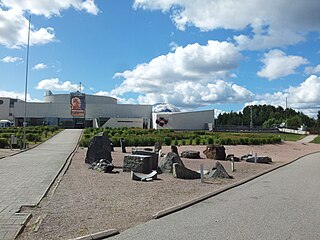
Heureka is a Finnish science center in the Tikkurila district of Vantaa, Finland, north of Helsinki, designed by Heikkinen – Komonen Architects. It is located at the intersection of the Finnish Main Line and the river Keravanjoki.

Telus World of Science Edmonton (TWOSE) is a broad-based science centre in Edmonton, Alberta, Canada, operated by the (non-profit) Edmonton Space & Science Foundation. The centre is located on the southwest corner of Coronation Park in the neighborhood of Woodcroft. The science centre houses 144,430 sq. ft. of public space and is the largest science centre in Western Canada. It is currently a member of both the Association of Science-Technology Centers (ASTC) and the Canadian Association of Science Centres (CASC).
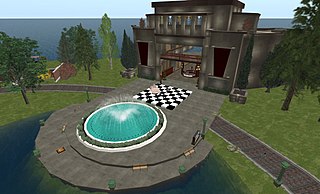
A virtual museum is a digital entity that draws on the characteristics of a museum, in order to complement, enhance, or augment the museum experience through personalization, interactivity, and richness of content. Virtual museums can perform as the digital footprint of a physical museum, or can act independently, while maintaining the authoritative status as bestowed by the International Council of Museums (ICOM) in its definition of a museum. In tandem with the ICOM mission of a physical museum, the virtual museum is also committed to public access; to both the knowledge systems embedded in the collections and the systematic, and coherent organization of their display, as well as to their long-term preservation. As with a traditional museum, a virtual museum can be designed around specific objects, or can consist of online exhibitions created from primary or secondary resources. Moreover, a virtual museum can refer to the mobile or World Wide Web offerings of traditional museums ; or can be born digital content such as, 3D environments, net art, virtual reality and digital art. Often, discussed in conjunction with other cultural institutions, a museum by definition, is essentially separate from its sister institutions such as a library or an archive. Virtual museums are usually, but not exclusively delivered electronically when they are denoted as online museums, hypermuseum, digital museum, cybermuseums or web museums.

Nehru Science Centre (NSC) is the largest interactive science centre in India. It is located in Worli, Mumbai. The centre is named after India's first Prime Minister, Jawaharlal Nehru. In 1977, the centre started with the 'Light and Sight' exhibition, and then in 1979 a Science Park was built. On 11 November 1985 it was opened to the public by Rajiv Gandhi, the then Prime Minister of India.
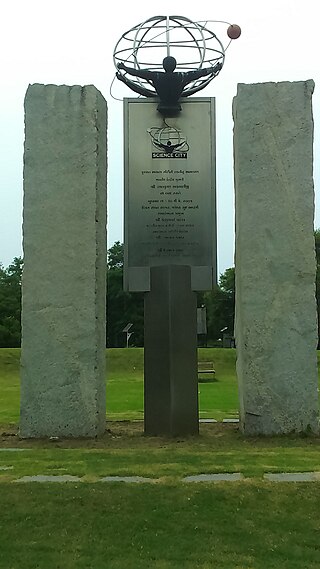
Gujarat Science City is a science education and entertainment centre located in Ahmedabad, Gujarat, India. Opened in 2002 and expanded in 2021, it has an IMAX 3D theatre; exhibitions on science, space, energy park, life science park, planet earth, hall of science, musical fountain, thrill ride, plants, nature and robotics; an aquarium, an aviary and a butterfly park; as well as other facilities.
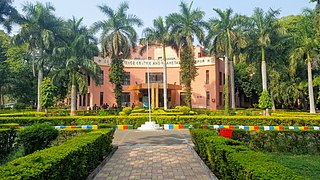
The Raman Science Centre and Raman Planetarium Complex at Nagpur is an interactive science centre affiliated with Mumbai's Nehru Science Centre. The centre was developed to promote a scientific attitude, portray the growth of science and technology and their applications in industry and human welfare, and hold science exhibits. The centre is named after famous Nobel Prize winner Indian physicist Chandrasekhara Venkata Raman.
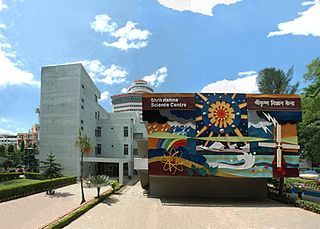
Shrikrishna Science Centre is a science museum in Patna, Bihar, India which was named after the first Chief Minister of Bihar, Shri Krishna Sinha. It was inaugurated on 14 April 1978, by the Minister of Education, Shri Thakur Prasad Singh. Shrikrishna Science Centre forms a unit of the National Council of Science Museums, an autonomous body under the Ministry of Culture, Government of India. It is located in the southwestern corner of the Gandhi Maidan. The science centre has been set up for the benefit of the public, especially students. A new innovation hub also been set up to promote critical thinking through activities in science. Various facilities like 3D printing, broadband internet facilities as well as advanced labs are available.

Nehru Centre is a centre to promote the teachings and ideals of the first Prime Minister of India, Jawaharlal Nehru, through educational and cultural programmes in the city of Mumbai, India. The Centre organises scientific, cultural and educational activities.

Copernicus Science Centre is a science museum standing on the bank of the Vistula River in Warsaw, Poland. It contains over 450 interactive exhibits that enable visitors to single-handedly carry out experiments and discover the laws of science for themselves. The centre is the largest institution of its type in Poland and one of the most advanced in Europe. In 2018, since its opening, it has been visited by over 8 million people.

The National Science Centre established in 1992, is a science museum in Delhi, India. It is part of the National Council of Science Museums (NCSM), an autonomous body under India's Ministry of Culture. It stands close to Gate no 1, of Pragati Maidan overlooking the Purana Qila.
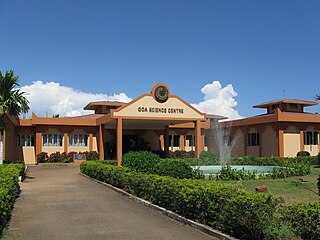
The Goa Science Centre is a science museum, located on New Marine Highway, Miramar, Panjim. It is a joint project of a division of India's National Council of Science Museums (NCSM) and Goa's Department of Science Technology & Environment.
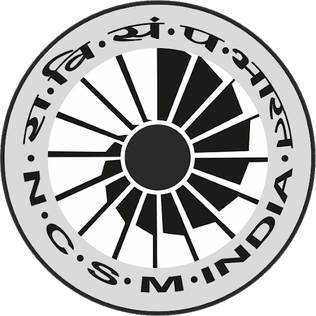
National Council of Science Museums (NCSM) is an autonomous scientific organization functioning under the Ministry of Culture, Government of India for science communication through its network of science museums or science centres spread across India. It is the largest chain of science centers/museums under a single administrative umbrella in the world. There are 24 own science centers or museums and one R & D laboratory and training centre. The NCSM has been built to co-ordinate all informal science communication activities in the museum space in the country.
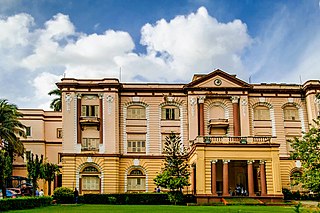
Birla Industrial & Technological Museum (BITM) is a science museum in Kolkata, West Bengal, India. It is a unit under National Council of Science Museums (NCSM), Ministry of Culture, Government of India. Initially under the governmental jurisdiction of the Council of Scientific & Industrial Research (CSIR), BITM is commonly recognized as the precursor of India's science museum concept.

B. M. Birla Planetarium is a large planetarium in Chennai, India. The fifth B. M. Birla planetarium in the country, it is located at Kotturpuram in the Periyar Science and Technology Centre campus which houses eight galleries, namely, Physical Science, Electronics and Communication, Energy, Life Science, Innovation, Transport, International Dolls and Children and Materials Science, with over 500 exhibits. Built in 1988 in the memory of the great industrialist and visionary of India B. M. Birla, it is considered the most modern planetarium in India, providing a virtual tour of the night sky and holding cosmic shows on a specially perforated hemispherical aluminium inner dome. Other Birla planetariums in India include the M. P. Birla Planetarium in Kolkata, the Birla Planetarium in Hyderabad, and the planetariums in Tiruchirapalli and Coimbatore.

Ranchi Science Centre is the first science centre in the state of Jharkhand in India, under Jharkhand Council on Science & Technology (JCST) of Department of Science & Technology, Government of Jharkhand (GOJ). The centre comprises two storied building that houses three permanent thematic galleries of covered area 42,000 square meter on an area of 13 acre land, provided by Government of Jharkhand, at Chiraundi village, Morhabadi near the Tagore Hill adjacent to Ranchi town at a capital cost of Rs. 87.5 crore or $1,374,494 which has been shared equally by Government of Jharkhand and Government of India. The science centre has been developed by the National Council of Science Museums (NCSM), a wing of Ministry of Culture, Govt. of India. The centre was inaugurated by the chief minister Arjun Munda on 29 November 2010.
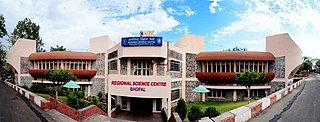
The Regional Science Centre, Bhopal (RSCB) is located in the Shyamla Hills area of Bhopal, India. It is aimed at popularizing science and technology among the people, particularly the students. It is one of the constituent units of the National Council of Science Museums or NCSM. RSCB was inaugurated on 12 January 1995 by the then president of India Shankar Dayal Sharma.

Parque de las Ciencias is a science center and museum located in the city of Granada, Spain. It is a member of the European Network of Science Centers and Museums (ECSITE). The facility encompasses 70,000 square meters and offers a variety of experiences. These include permanent and temporary exhibits, a planetarium, educational spaces, and amenities like a cafe, restaurant, bookstore, library, and cinemas. Additionally, the Parque de las Ciencias has unique features such as a plastination lab and restoration and production workshops.
The Tamil Nadu Science and Technology Centre (TNSTC) is a science museum and educational institution in Chennai, India. Established in 1983, it operates under the Government of Tamil Nadu's Department of Higher Education. The centre serves as a hub for science education and awareness, housing several major facilities including the Periyar Science and Technology Centre, the B. M. Birla Planetarium, and various specialized galleries.


















